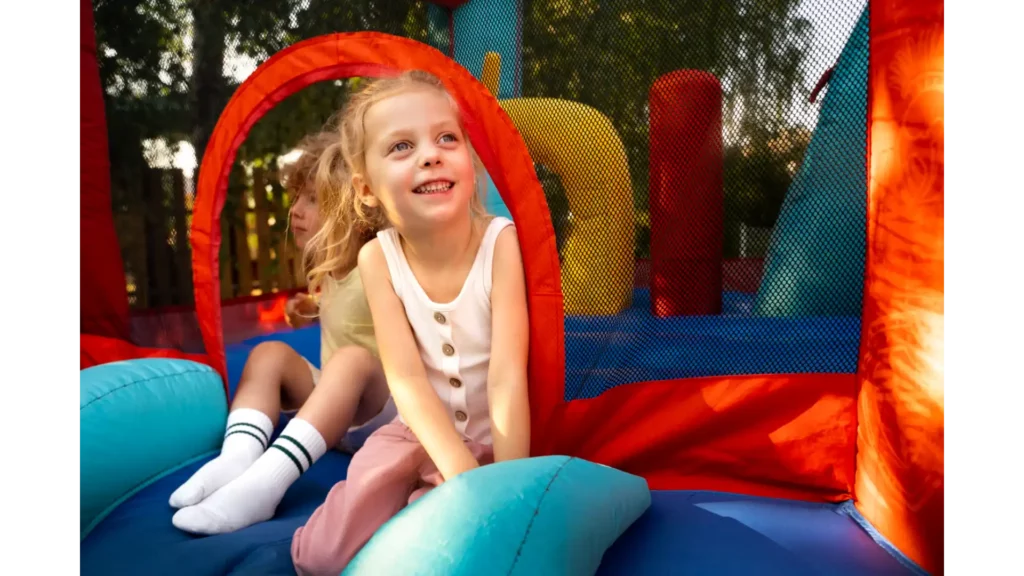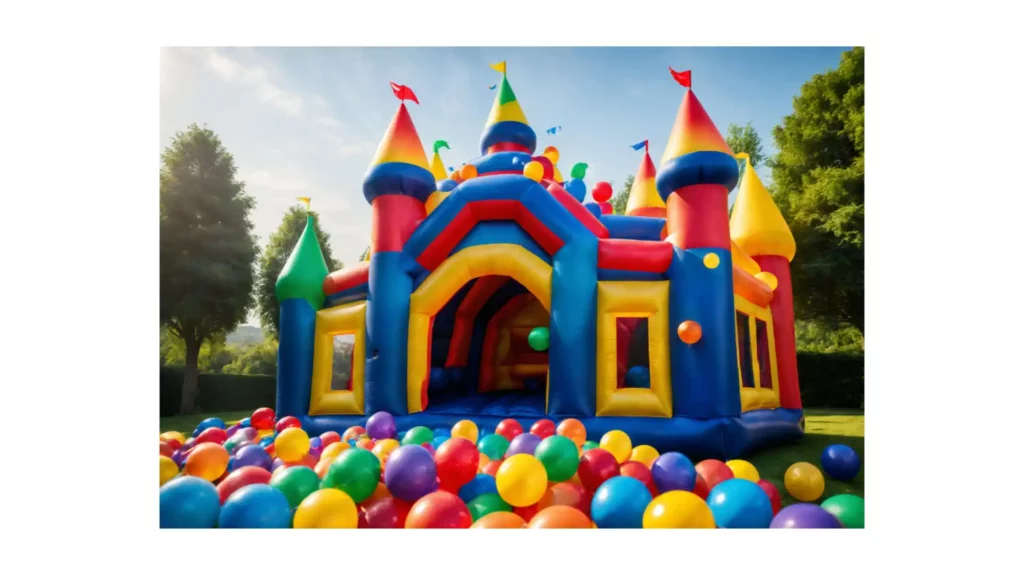Bounce houses, also known as inflatable castles or moonwalks, are a popular choice for children's parties and events.
These inflatable structures provide hours of entertainment and joy for kids, but have you ever wondered about their energy consumption?
In this comprehensive guide, we'll delve into the energy usage of bounce houses and answer the burning question: How much electricity does a bounce house use?
Understanding Bounce Houses and Their Energy Consumption
Bounce houses, also known as inflatable castles or moonwalks, are not merely air-filled structures but complex systems reliant on electric blowers to maintain their buoyancy.
These blowers tirelessly pump air into the inflatable, ensuring its firmness and elasticity, thereby allowing children to revel in the joy of bouncing.
The energy consumption of a bounce house is contingent upon a multitude of factors, ranging from the size and design of the inflatable to the power rating of the blower and the duration of its operation.

Factors Affecting the Energy Consumption of Bounce Houses
- Size of the Bounce House: Larger bounce houses require more power to keep them inflated compared to smaller ones. The size of the bounce house directly impacts its energy consumption.
- Power Rating of the Blower: The power rating of the blower, measured in watts or horsepower, determines how much electricity it consumes during operation. Higher-powered blowers will consume more electricity.
- Duration of Use: The longer a bounce house is in operation, the more electricity it will consume. Extended use of bounce houses, especially for events lasting several hours, can significantly impact energy consumption.
- Temperature and Weather Conditions: Extreme temperatures impact energy use in bounce houses. Hot weather makes the blower work harder, increasing energy consumption. Cold weather causes air to contract, making the blower run more often.
- Inflation Pressure: The inflation pressure of a bounce house affects energy consumption. Over-inflating makes the blower work harder, using more energy. Under-inflating saves energy but may risk safety and structure.
- Air Leakage and Seal Quality: Air leaks in a bounce house can cause air loss, making the blower run more often. Regular maintenance to find and fix leaks is important to save energy and keep the blower running efficiently.
- Voltage and Electrical System: The bounce house's energy consumption is affected by voltage and electrical system condition. Inconsistent voltage or electrical problems can make the blower less efficient and use more energy.
- Type of Inflatable Material: The material of a bounce house affects its energy use. Thicker, more durable materials require more energy to inflate and maintain pressure than lighter materials.

Calculating the Energy Consumption of a Bounce House
To estimate the energy consumption of a bounce house, you can use the following formula:
Energy Consumption (kWh)=Power of Blower (kW)×Time of Use (hours)Energy Consumption (kWh)=Power of Blower (kW)×Time of Use (hours)
For example, if a bounce house has a blower with a power rating of 1.5 kW and is used for 4 hours, the energy consumption would be:
Energy Consumption=1.5 kW×4 hours=6 kWhEnergy Consumption=1.5 kW×4 hours=6 kWh
Tips for Reducing Energy Consumption
- Opt for Energy-Efficient Models: When purchasing or renting a bounce house, choose models with energy-efficient blowers that consume less electricity without compromising performance.
- Monitor Usage Time: Limit the duration of bounce house usage to conserve energy. Consider scheduling breaks or rotating groups of children to reduce continuous operation.
- Proper Maintenance: Ensure that the bounce house and blower are well-maintained to optimize performance and minimize energy wastage.
- Switch to Renewable Energy: If possible, power bounce houses using renewable energy sources such as solar or wind power to reduce environmental impact.

Alternative Power Sources for Bounce Houses
In addition to traditional electricity from the grid, there are alternative power sources that can be utilized to operate bounce houses, offering both environmental benefits and potential cost savings.
Exploring these options can be a great way to reduce your carbon footprint and promote sustainability while still enjoying the fun of bounce houses.
Solar Power
Solar power uses sunlight to create electricity, making it a renewable energy source. Installing solar panels on bounce houses can power the blower with clean energy, perfect for outdoor events with plenty of sunlight.
Benefits of solar energy for bounce houses include:
- Environmentally Friendly: Solar power produces zero greenhouse gas emissions, making it a clean and sustainable energy source that helps reduce environmental impact.
- Cost Savings: While the initial investment in solar panels may be higher, over time, solar power can lead to significant cost savings on electricity bills, especially for frequent users of bounce houses.
- Off-Grid Capability: Solar-powered bounce houses can operate independently of the electrical grid, making them suitable for remote locations or areas without access to traditional power sources.
Battery Power
Battery-powered bounce houses use rechargeable batteries for energy, which can be charged from the grid or solar power, providing flexibility in operation.
Advantages of battery power for bounce houses include:
- Portability: Battery-powered bounce houses are highly portable and can be used in locations where access to electricity is limited or unavailable, such as parks, beaches, or outdoor events.
- Quiet Operation: Unlike traditional electric blowers, battery-powered blowers operate silently, creating a quieter and more peaceful environment for users.
- Zero Emissions: Battery-powered bounce houses produce zero emissions during operation, making them an eco-friendly alternative to traditional electricity.
Wind Power
Wind power uses wind to make electricity for bounce houses. Turbines capture wind energy to power blowers.
Advantages of wind power for bounce houses include:
- Renewable Resource: Wind power is a renewable resource that produces no greenhouse gas emissions, making it an environmentally sustainable option for powering bounce houses.
- Scalability: Wind turbines come in various sizes, allowing for scalability to meet the energy needs of different-sized bounce houses or inflatable structures.
- Long-Term Cost Savings: While the initial investment in wind turbines may be higher, wind power can lead to long-term cost savings on electricity bills, especially in windy areas with consistent airflow.

Future Trends and Innovations
As technology continues to advance, the world of bounce houses is also evolving to meet the demands of consumers and the growing need for sustainability. Here are some future trends and innovations that are shaping the future of bounce houses:
- Smart Bounce Houses
With the rise of the Internet of Things (IoT), we can expect to see bounce houses equipped with smart sensors and connectivity features.
These smart bounce houses will be able to monitor factors such as air pressure, temperature, and occupancy in real-time, providing valuable data to optimize performance and safety.
- Interactive Feature
Future bounce houses may incorporate interactive elements such as augmented reality (AR) games, projection mapping, and interactive LED lighting.
These features will enhance the overall experience for children and provide new ways to engage with inflatable structures.
- Modular and Customizable Designs
Bounce houses of the future may feature modular designs that allow for easy customization and reconfiguration.
This will enable users to create unique layouts and configurations tailored to their specific needs and preferences.
- Green Technologies
As environmental sustainability becomes increasingly important, future bounce houses are likely to integrate green technologies such as solar-powered blowers, recycled materials, and eco-friendly manufacturing processes.
These innovations will help reduce the carbon footprint of bounce houses and promote environmental conservation.
- Safety Enhancements
Advances in materials science and engineering will lead to the development of safer and more durable bounce houses.
Future designs may incorporate advanced safety features such as impact-absorbing materials, reinforced seams, and automatic emergency deflation systems to enhance overall safety for users.

FAQs (Frequently Asked Questions)
1. Are all bounce houses equally energy-efficient?
While most bounce houses operate using electric blowers, their energy efficiency can vary depending on factors such as the design, size, and power rating of the blower. Opting for models with energy-efficient blowers can help reduce electricity consumption.
2. How can I determine the power rating of the blower in a bounce house?
The power rating of the blower is typically listed in kilowatts (kW) or horsepower (HP) on the manufacturer's specifications. You can also consult the user manual or contact the manufacturer for information on the blower's power consumption.
3. Can using a bounce house on a windy day reduce its energy consumption?
Yes, using a bounce house on a windy day can potentially reduce its energy consumption. The natural airflow may assist in keeping the inflatable structure partially inflated, thereby reducing the workload on the blower and decreasing overall energy usage.
4. Are there any safety considerations related to reducing bounce house energy consumption?
While reducing bounce house energy consumption is important, it's crucial to prioritize safety at all times. Ensure that the bounce house remains adequately inflated to prevent accidents or collapses, even when implementing energy-saving measures such as lowering blower power or usage time.
5. Can I use a generator to power a bounce house?
Yes, you can use a generator to power a bounce house if electricity is not readily available at your event location. However, it's essential to use a generator that meets the power requirements of the bounce house and to follow proper safety precautions when operating generators.
6. Are there any alternative power sources for bounce houses besides electricity?
Yes, there are alternative power sources for bounce houses, such as solar or battery-powered blowers. These options can be particularly beneficial for outdoor events or locations where access to electricity is limited, providing a more sustainable and environmentally-friendly energy solution.
7. Can bounce houses be used indoors?
Yes, bounce houses can be used indoors, but it's essential to ensure that the space is large enough to accommodate the inflatable structure safely. Additionally, proper ventilation and access to electrical outlets must be considered when setting up a bounce house indoors.
8. How can I estimate the energy consumption of a bounce house for my event?
To estimate the energy consumption of a bounce house, you can multiply the power rating of the blower (in kW) by the duration of use (in hours). This will give you the energy consumption in kilowatt-hours (kWh), allowing you to plan accordingly and minimize energy usage where possible.
How Much Electricity Does a Bounce House Use Conclusion
While bounce houses provide endless fun and entertainment for children, it's essential to consider their energy consumption.
By understanding the factors that affect energy usage and implementing energy-saving practices, you can minimize the environmental impact of bounce house usage.
Whether you're planning a birthday party or a community event, being mindful of energy consumption is key to enjoying bounce houses responsibly.

